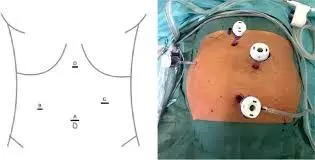Robotic cholecystectomy safe alternative to laparoscopic approach for gallbladder surgery: Study

Robotic cholecystectomy safe alternative to laparoscopic approach for gallbladder surgery suggests a study published in the 65th Annual meeting at Washington DC.
The safety of robotic cholecystectomy remains a topic of intense debate. Data on robotic cholecystectomy is now available in the NSQIP 2022 Participant Use Data File (PUF). Herein, we evaluate the safety of robotic vs laparoscopic cholecystectomy. Using the NSQIP 2022, patients who underwent robotic and laparoscopic cholecystectomy were identified. Patients with malignant diagnoses were excluded. Primary outcomes were Clavien-Dindo ≥ III complications and conversion to open. Secondary outcomes were reoperation, readmission, and increased length of stay. RESULTS: Of the 60017 patients identified, 54407 underwent laparoscopic cholecystectomy and 5610 robotic. Most patients were female (67.6%), white (63.6%), and underwent surgery for acute and/or chronic cholecystitis (71.5%) in an elective (64.0%) and outpatient setting (57.8%). Compared to the laparoscopic group, patients who underwent robotic cholecystectomy had a lower rate of serious complications: 2.6 vs 3.7% (p<.0001), lower conversion to open: 0.8 vs 2.0% (p<.0001), lower reoperation rate: 0.6 vs 0.9% (p=0.02), lower readmission rate: 3.6 vs 4.2% (p=0.03) and a lower rate of hospitalization > 24h: 32.5 vs 48.2% (p<.0001). Multivariable logistic regression revealed that laparoscopic cholecystectomy compared to the robotic approach was independently associated with higher odds of conversion to open (OR 2.10, 95%CI 1.55-2.85) and need for hospitalization > 24h (OR 1.26, 95%CI 1.18-1.35). There were no significant differences between the two approaches in terms of Clavien-Dindo > III complications (OR 1.16, 95%CI 0.97-1.38), reoperation (OR 1.35, 95%CI 0.95-1.92), and readmission (OR 1.09, 95%CI 0.94-1.27). Robotic cholecystectomy was independently associated with lower odds of conversion to open and need for hospitalization > 24h, without increasing the risk of serious complications, need for reoperation or readmission. These findings suggest that facilitating the adoption of new technologies that can enhance the safety of laparoscopic surgery is warranted.
Reference:
ROBOTIC VERSUS LAPAROSCOPIC CHOLECYSTECTOMY: A NSQIP COMPARATIVE ANALYSIS. Felipe B. Maegawa*1, Jamil Stetler1, Dipan Patel1, Snehal Patel1, Edward Lin1, Federico Serrot2, Ankit Patel. Surgery, Emory University School of Medicine, Atlanta, GA; 2Cleveland Clinic Florida, Weston, FL
Keywords:
Robotic, cholecystectomy, safe, alternative, laparoscopic, approach, gallbladder surgery, study



